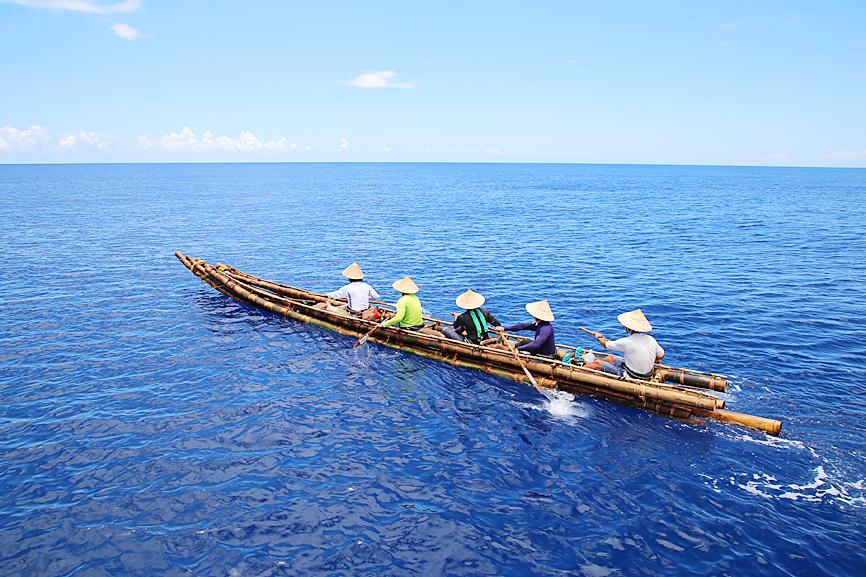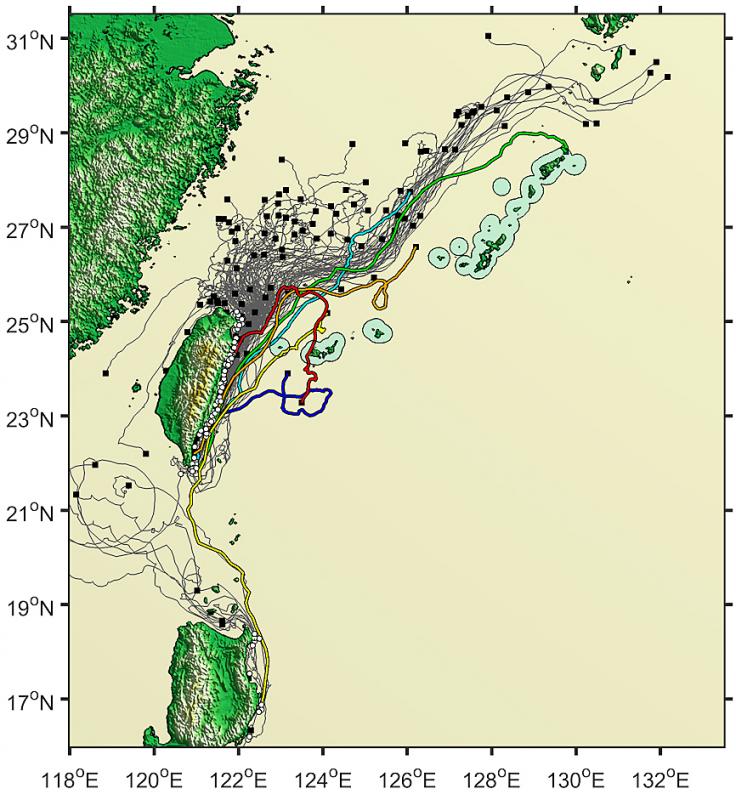About 30,000 years ago, ancient inhabitants of Taiwan might have intentionally crossed the Kuroshio, one of the world’s strongest currents, researchers found.
They might have searched for a new habitat and reached the Ryukyu Islands in Japan, said a study, titled “Palaeolithic voyage for invisible islands beyond the horizon,” which was published in the journal Scientific Reports on Thursday.
The study, led by anthropologist Yousuke Kaifu, a ancient history researcher at the University of Tokyo, is part of a project on maritime migration of Paleolithic people 35,000 to 30,000 years ago.

Photo courtesy of University of Tokyo professor Yousuke Kaifu
While some of them are believed to have migrated from Taiwan to the Ryukyu Islands, it has been unclear whether their voyages were made by chance or choice.
“I had been seeking a good way to demonstrate the intentionality of the sea crossings, but had no idea what to do. Then, I ... came across the idea of using the tracking buoys,” Kaifu wrote in an e-mail to the Taipei Times.
Kaifu, with the help of Jan Sen (詹森), a professor at National Taiwan University’s Institute of Oceanography, and former technician Kuo Tien-hsia (郭天俠), analyzed data of the movements of 138 satellite-tracked buoys that drifted past the Philippines, Taiwan and Japan from 1989 to 2017.

Photo courtesy of former National Taiwan University technician Kuo Tien-hsia
The methodology was predicated on some evidence showing that the Kuroshio’s flow remained unchanged over the past 100,000 years, the team said.
Of the 122 buoys that drifted past Taiwan, 114 were carried northward by the Kuroshio, and of these, only three came within 20km of the central and southern Ryukyu Islands, the researchers found.
This usually happened under severe weather conditions, such as typhoons and northeasterly monsoons, they found.
Of the 16 buoys that drifted past the Philippine main island of Luzon, only one drifted toward the Ryukyu Islands, they found.
The ancient sailors could not have reached the Ryukyu Islands through random drifting, whereas bad weather conditions, although occasionally bringing some buoys closer to the islands, are unlikely to have been used by the ancient seafarers, Jan said.
Yonaguni Island, the westernmost of the Ryukyu Islands, is in good weather conditions visible from some mountains in eastern Taiwan, he added.
The movements of the buoys, originally deployed by the US-led Surface Velocity Program, show the possible routes of ancient voyages, Jan said, adding that their method can be described as “mining old data for a new application.”
Asked if there were conditions unfavorable for survival in Taiwan that prompted the Paleolithic people to move, Kaifu said that if there were such conditions, people might have sought to relocate within Taiwan.
“You really do not have to go to that remote island, but they did,” Kaifu said. “I think that is human nature.”
“It must be a one-way trip. The Kuroshio current is too strong to come back, even if they plan a round trip,” he added.
In July last year, a team of five paddled from Taitung to Yonaguni Island in a logboat, covering the 225km in 45 hours.
Kaifu said he seeks to document the research in further academic papers, books and films, including a short film that would be screened in Tokyo this month.
Asked if the migration from Taiwan was the first known sea crossing to Japan, Kaifu said that ancient populations also crossed the sea from the Korean Peninsula, adding that the first residents of the Ryukyu Islands were not necessarily the ancestors of modern Japanese.
“This project is to highlight a part of interesting human histories, not to applaud someone. I do not want to be nationalistic in my anthropological studies,” he said.

US climber Alex Honnold is to attempt to scale Taipei 101 without a rope and harness in a live Netflix special on Jan. 24, the streaming platform announced on Wednesday. Accounting for the time difference, the two-hour broadcast of Honnold’s climb, called Skyscraper Live, is to air on Jan. 23 in the US, Netflix said in a statement. Honnold, 40, was the first person ever to free solo climb the 900m El Capitan rock formation in Yosemite National Park — a feat that was recorded and later made into the 2018 documentary film Free Solo. Netflix previewed Skyscraper Live in October, after videos

Starting on Jan. 1, YouBike riders must have insurance to use the service, and a six-month trial of NT$5 coupons under certain conditions would be implemented to balance bike shortages, a joint statement from transportation departments across Taipei, New Taipei City and Taoyuan announced yesterday. The rental bike system operator said that coupons would be offered to riders to rent bikes from full stations, for riders who take out an electric-assisted bike from a full station, and for riders who return a bike to an empty station. All riders with YouBike accounts are automatically eligible for the program, and each membership account

NUMBERS IMBALANCE: More than 4 million Taiwanese have visited China this year, while only about half a million Chinese have visited here Beijing has yet to respond to Taiwan’s requests for negotiation over matters related to the recovery of cross-strait tourism, the Tourism Administration said yesterday. Taiwan’s tourism authority issued the statement after Chinese-language daily the China Times reported yesterday that the government’s policy of banning group tours to China does not stop Taiwanese from visiting the country. As of October, more than 4.2 million had traveled to China this year, exceeding last year. Beijing estimated the number of Taiwanese tourists in China could reach 4.5 million this year. By contrast, only 500,000 Chinese tourists are expected in Taiwan, the report said. The report

Temperatures are forecast to drop steadily as a continental cold air mass moves across Taiwan, with some areas also likely to see heavy rainfall, the Central Weather Administration (CWA) said. From today through early tomorrow, a cold air mass would keep temperatures low across central and northern Taiwan, and the eastern half of Taiwan proper, with isolated brief showers forecast along Keelung’s north coast, Taipei and New Taipei City’s mountainous areas and eastern Taiwan, it said. Lows of 11°C to 15°C are forecast in central and northern Taiwan, Yilan County, and the outlying Kinmen and Lienchiang (Matsu) counties, and 14°C to 17°C